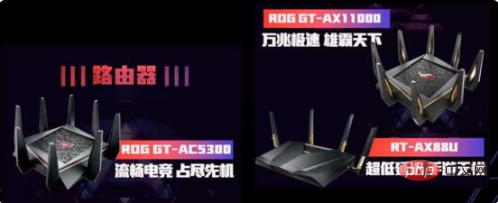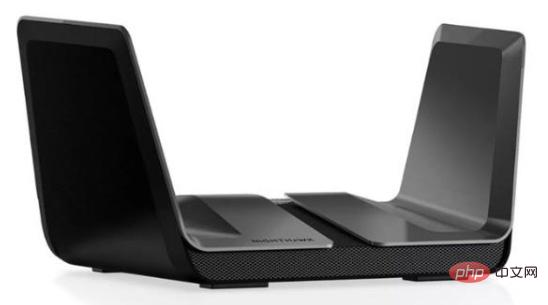What are the wifi6 routers?

As early as April 2018, ASUS took the lead in laying out WiFi 6 routing, and successively released the ROG 10G e-sports router GT-AX11000, mobile game router RT-AX88U and e-sports mesh RT -AX92U three new products. Following WiFi 5, ASUS AX router has once again become the pioneer and leader in the WiFi 6 industry.

Related recommendations: "php Video Tutorial"
It is reported that in addition to the above products, ASUS has further enriched Wi-Fi 6 products line, launching the new Special Forces TUF GAMEING AX3000 in early October.
Netgear has officially launched two routers that support WiFi6: Nighthawk AX8 and Nighthawk AX12.

The AX8 is the lower-end model, with two 4 x 4 antenna arrays (one for 5GHz Wi-Fi and one for 2.4GHz), Five Gigabit Ethernet ports and supports a total of 6GHz of wireless throughput. The AX12 is a bit more high-end, but its 5GHz network includes an 8 x 8 antenna array, which Netgear says has better long-range stability, as well as a faster processor and 5Gb Ethernet port.
The above is the detailed content of What are the wifi6 routers?. For more information, please follow other related articles on the PHP Chinese website!

Hot AI Tools

Undresser.AI Undress
AI-powered app for creating realistic nude photos

AI Clothes Remover
Online AI tool for removing clothes from photos.

Undress AI Tool
Undress images for free

Clothoff.io
AI clothes remover

AI Hentai Generator
Generate AI Hentai for free.

Hot Article

Hot Tools

Notepad++7.3.1
Easy-to-use and free code editor

SublimeText3 Chinese version
Chinese version, very easy to use

Zend Studio 13.0.1
Powerful PHP integrated development environment

Dreamweaver CS6
Visual web development tools

SublimeText3 Mac version
God-level code editing software (SublimeText3)

Hot Topics
 1377
1377
 52
52
 What does router sys mean?
Aug 23, 2022 am 10:42 AM
What does router sys mean?
Aug 23, 2022 am 10:42 AM
The sys of the router means system operating status indication, and the full name is System; the router uses the sys indicator light to inform the user of the operating status of the device. If the router is faulty or restarting, the indicator light will flash; the indicator light of the router can be divided into power Indicator light, sys system indicator light, LAN indicator light and WAN indicator light.
 Is wifi7 compatible with WiFi6 devices?
Mar 06, 2024 pm 08:49 PM
Is wifi7 compatible with WiFi6 devices?
Mar 06, 2024 pm 08:49 PM
After WiFi7 comes out, it can bring users a better Internet experience. However, many users are confused about whether their WiFi6 devices are compatible with WiFi7. Don't worry about this, the two are compatible. Is wifi7 compatible with WiFi6 devices? Answer: Compatible According to previous practice, the new generation of wireless communication technologies are backward compatible. That is to say, after the WIFI7 router is released in the future, it will normally be compatible with WIFI6. 1. Wi-Fi-7 is also called Extremely high throughput for 802.11. 2. Wi-Fi-7 will be backwards compatible with previous Wi-Fi standards, so we don’t have to worry about Wi-Fi6 or Wi-Fi6E devices not working properly on new routers. 3. Currently
 Can the router be placed upside down?
Sep 22, 2023 pm 02:11 PM
Can the router be placed upside down?
Sep 22, 2023 pm 02:11 PM
Can. However, you need to pay attention to some issues: 1. Placing the router upside down may have a certain impact on heat dissipation, causing heat to accumulate at the bottom of the router, affecting the heat dissipation effect. Long-term overheating may reduce the performance of the router and adversely affect its lifespan. ; 2. Placing the router upside down may affect the operation and management of the device, and the indicator lights and interfaces may be blocked or inconvenient to operate; 3. Placing the router upside down may also have a certain impact on network security, and the default user name and password may cause This information is more susceptible to prying eyes.
 What does router sn mean?
Oct 27, 2022 pm 05:21 PM
What does router sn mean?
Oct 27, 2022 pm 05:21 PM
In routers, sn stands for "Serial Number", which means "serial number" and refers to the factory number of the router. The router serial number (SN) and physical address are both hardware identifiers, which are unique; the router will be under warranty only if the router's serial number is kept intact. The router serial number SN can be seen directly in the manual and on the back of the router.
 What are the benefits of turning on ipv6 on the router 'Advantages of using the latest IPv6'
Feb 06, 2024 pm 05:34 PM
What are the benefits of turning on ipv6 on the router 'Advantages of using the latest IPv6'
Feb 06, 2024 pm 05:34 PM
Students who know computers all know that if our computer wants to connect to the network, it must have an IP address. This IP address can be manually configured, such as 172.16.19.20; it can also be automatically obtained by the DHCP server of the computer network card, such as 192.168.1.100 etc. These IP addresses are what we often call IPV4 addresses, and the corresponding IPV6 is also a type of IP address. What is IPV6 IPV6 is a new IP address that emerged in response to the exhaustion of IPV4 address resources. Its full name is "Internet Protocol Version 6", and its Chinese name is the sixth generation of Internet Protocol. The number of IPv6 addresses is theoretically 2^128
 How many lights on the router are normal? 'Recommended detailed explanation of the normal status of the router indicator lights'
Feb 06, 2024 pm 09:12 PM
How many lights on the router are normal? 'Recommended detailed explanation of the normal status of the router indicator lights'
Feb 06, 2024 pm 09:12 PM
The first light is on, indicating that the router is powered on. Which port is plugged in, the light of which port is on, and flashing means data is being transmitted. Wireless routers usually have three indicator lights: SYS, LAN and WAN. When the wireless router is powered on, the SYS light will light up. When the wireless router is connected to the network modem, the WAN light will light up. The LAN light corresponds to each interface of the wireless router. As long as the network cable is inserted into the corresponding interface, the corresponding LAN light will light up. 1. If it keeps flashing, it means it is transmitted by data, and the router settings should be normal. 2. If you have always been able to access the Internet, but you can't get online recently; it is probably a problem with the external line, that is, a problem with the operator (usually there is a problem with the line, causing the data signal to attenuate too much, although the line is good)
 Are ipv6 and wifi6 the same thing? Introduction to the difference between ipv6 and wifi6
Mar 14, 2024 pm 08:34 PM
Are ipv6 and wifi6 the same thing? Introduction to the difference between ipv6 and wifi6
Mar 14, 2024 pm 08:34 PM
IPv6, the full name of "Internet Protocol Version 6", is the next generation IP protocol designed by the Internet Engineering Task Force (IETF) to replace IPv4. Then some users asked, are ipv6 and wifi6 the same thing? Are these two the same? Of course they are different, let’s take a look at the detailed introduction below. The difference between ipv6 and wifi6: 1. First of all, ipv6 is an "IP protocol", while wifi6 is a "wifi standard". 2. IPv6 is an upgraded version of IPv4 and is used to solve the problem of insufficient network address resources. 3. In short
 Why can't I access the Internet even though I'm connected to the router?
Nov 24, 2023 pm 05:29 PM
Why can't I access the Internet even though I'm connected to the router?
Nov 24, 2023 pm 05:29 PM
Reasons why the router is connected but cannot access the Internet: 1. Internet service provider problem; 2. Router setting problem; 3. LAN problem; 4. WiFi signal problem; 5. Router hardware problem; 6. DNS problem; 7. Network cache problem ; 8. Firewall and security software issues; 9. Operator restrictions; 10. Equipment failure. Detailed introduction: 1. Internet service provider problems. This is a common reason. Internet service providers may have problems, such as network interruption or service interruption; 2. Router setting problems, etc.



